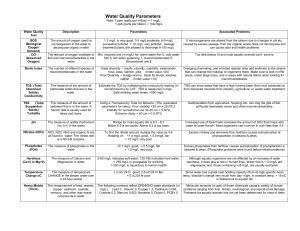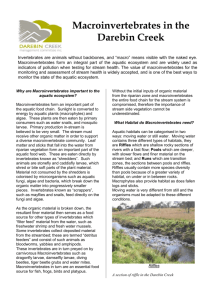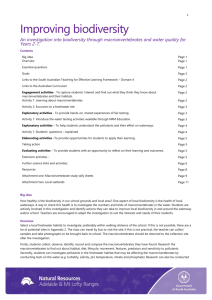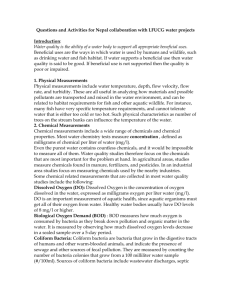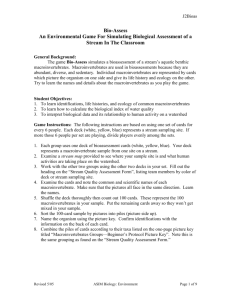Example of an "A" term paper
advertisement
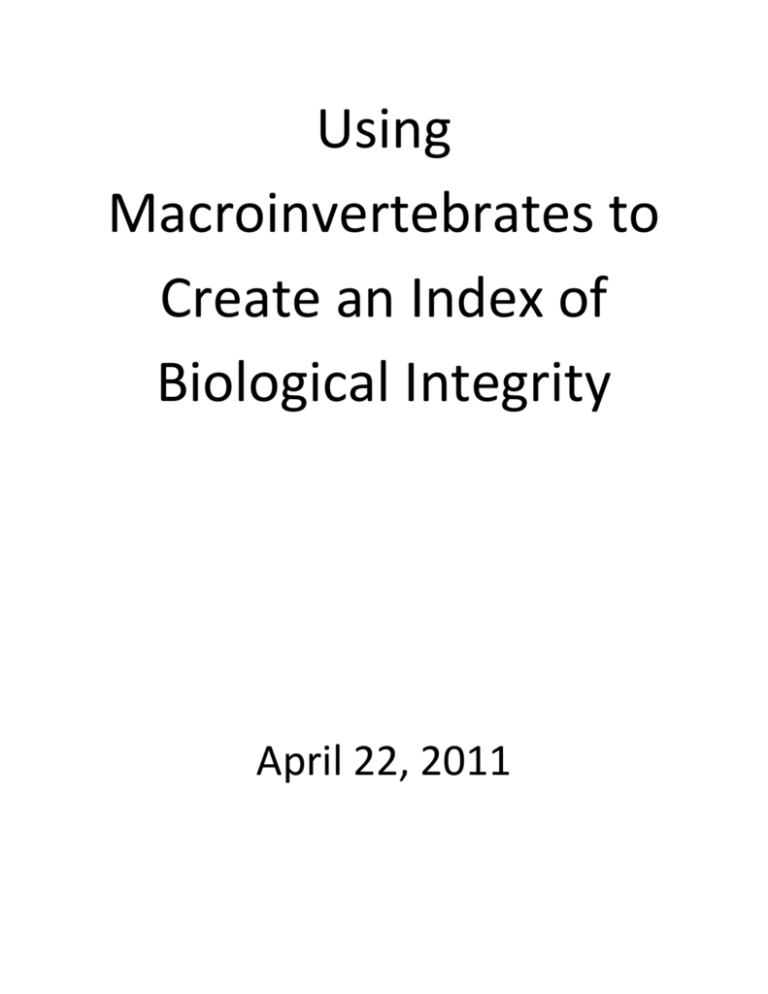
Using Macroinvertebrates to Create an Index of Biological Integrity April 22, 2011 Table of Contents Introdction………………………………………………………………………………………………………………………………………Page 3 An Index of Biological Integrity………………………………………………………………………………………………………..Page 4 Creating an IBI…………………………………………………………………………………………………………………………………Page 5 Using Macroinvertebrates……………………………………………………………………………………………………………….Page 6 IBI Data……………………………………………………………………………………………………………………………………………Page 9 Why Use an IBI……………………………………………………………………………………………………………………………...Page 11 Conclusion…………………………………………………………………………………………………………………………………….Page 12 Citations………………………………………………………………………………………………………………………………………..Page 13 Introduction Humans are changing the face of the landscape faster than at any time in history. Very important parts of this landscape are the watersheds and waterways that provide us much of the water we use for everyday needs. Rivers and streams are affected by all activities that occur within their watersheds so they are able to provide valuable information about how our actions affect the landscape because human activity affects five attributes of watersheds and streams--water quality, habitat structure, stream flow patterns, sources of energy and nutrients, and biotic interactions. Human actions can also cause habitat destruction and disturbance, changing seasonal flow, introduction of or harvesting species that affect biotic interactions, and introducing chemical pollutants into water systems (Fore, Karr, Wissema, 1996). The Clean Water Act, Section 101 (a) states that, “The objective of this Act is to restore and maintain the chemical, physical, and biological integrity of the nation's waters.” However, in the past 25 years worth of water quality monitoring it has mainly only focused on chemical monitoring to meet human health goals. Although this focus has led to progress in improving and protecting our water quality more can be done. We are now realizing that with measuring stream biota, especially macroinvertebrates, we can detect a direct assessment of human activities on the water systems. Upon analysis of the biota we can try to determine if human influences are degrading the streams and the surrounding environment (Anderson, 2002). With the use of macroinvertebrates to focus on the biological integrity side and chemical monitoring there is a greater potential for better water quality. “Chemically clean waterways are good; living waterways are better (Karr, 1996).” Monitoring stream health and quality has become an important means for assessing and tracking environmental problems. Early assessments of stream health focused on the presence of certain pollutants, but unfortunately these measures are often difficult and/or expensive to make, are usually made at only one or a few times during a year, and therefore the data may represent a specific time, and therefore are more susceptible to short single affects rather than a flow of data that represent a much longer period of time (Fore, Karr, Wissema, 1996). An Index of Biological Integrity Different measures of biota have been used to assess community and ecosystem health because organisms are great integrators of community health, especially when you can examine and quantify entire communities. An example of this type of monitoring is aquatic macroinvertebrate monitoring in streams and rivers to determine an Index of Biological Integrity (United States, 1998). An Index of Biological Integrity (IBI) is a multistep process that assesses the biological integrity of a water system by using living organisms to evaluate the affects of human actions on these biological systems. “An IBI is made by combining several biological indicators, called metrics, into a summary index. A well-constructed IBI that can allow scientists to: (1) measure condition, (2) diagnose the type of stressors damaging a wetland's biota, (3) define management approaches to protect and restore biological condition, and (4) evaluate performance of protection and restoration activities. (Davis et al. 1996; U.S. EPA, 2005)” Why do IBI? Without this index much of human’s influences on water systems is going unnoticed. There are reports stating that just using chemical evaluations failed to detect 50% of the damage to water systems (Karr, 1997). This of course is a huge issue because if we are missing 50% of the issues in our water quality than it is possibly still strongly polluted even though chemical tests say it is not. There is also the fact that it can detect degradation caused by all of human’s changes to Earth’s surface, and not just the direct effects of chemical pollutants that more traditional evaluations only look at. Due to this fact, many state and federal agencies as well as other groups are developing programs that directly monitor and assess the condition of living water systems (Davis et al. 1996; U.S. EPA, 2005). Our water systems are affected by the largest and the smallest of human activities, and if you exclude looking at the biological effects of the water people drink, swim in, eat their fish from etc. you may be missing water systems that are possibly in severe stress. This index factor is an important tool that we must use and consider to determine and protect the, “ecologically intact places, restore degraded places, or make informed decisions about permits for development (Karr 1997).” Creating an IBI One way of setting a baseline and measuring restoration success is to define the normal biological integrity of a system, and then measure deviations from it (Karr, 1997); the Index of Biological Integrity does this. The Index’s metrics are chosen because they can show the precise and expected responses of the invertebrates, fish, etc. to human actions throughout landscapes. Ecological response curves can be created with the data collected from the metrics because they provide an integrative measure of the cumulative impacts of human activities in a water system (Karr, 1997). To create an IBI there are four main steps. First, you must select an assemblage: An assemblage is a group of plants and/or animals that will make up a larger group. Examples can include birds, amphibians, macroinvertebrates, etc. Second, you have to test and evaluate the metrics: A metric is a measurable component of a biological system with an empirical change in value along a gradient of human disturbance. Third, you combine metrics into an IBI where you assign scores of either a 5 (relatively undisturbed), 3 (moderately disturbed), or 1 (highly disturbed) to the metrics dependent on how they respond to human disturbances. Last, you test and validate IBI: test the IBI to see if it accurately detects the effects of human disturbances on the biological assemblage. In more detail: “The Index of Biological Integrity is based in empirically defined metrics because they: (1) are biologically and ecologically meaningful; (2) increase or decrease as human influence increases; (3) are sensitive to a range of stresses; (4) distinguish stress-induced variation from natural and sampling variation; (5) are relevant to societal concerns; and (6) are easy to measure and interpret (Karr, 1997).” I do wonder whether or not similar water systems in different regions react differently to the same human impacts. If they do then perhaps not all indices can be compared. Ideally to me if every water system had an original starting point to compare today’s values we would easily be able to determine if human affects are decreasing the environmental integrity of the system. Unfortunately this is almost never the case, and for now we should continue to improve the techniques we use today. The different metrics evaluate a plethora of data from the species collected. This includes the species themselves, how tolerant or intolerant they are of pollution, disease, nonindignenous species, and other anomalies that would normally not belong in that particular water ecosystem. Samples are collected and then sorted to be identified and counted; this can become a problem when the collectors are possibly inexperienced and do not necessarily know what they are looking for. Specific guidelines should be followed. The values for the metrics are then calculated, and these values are then compared to values that would be ‘normal’ for the same type water system. The metric scores are then tallied to determine an IBI where low values represent the more highly polluted and disturbed sites and high values represent the more relatively undisturbed sites (Karr, 1997). Using Macroinvertebrates Multimetric indexes were first created and used in the Midwestern United States by Dr. James Karr to be used in studying fish species. However, there are many water bodies that do not host an abundant amount of fish species, and so the IBI was soon adapted to use invertebrates. Benthic macroinvertebrates (small bottom dwelling aquatic organisms with no backbone) can be used as an indicator of water quality in streams, rivers or lakes. Early efforts at biological assessment focused on single or groups of indicator species that were either very tolerant or very intolerant of degraded habitat. This approach was built upon by use of community-level indices such as: diversity indices, species richness and species evenness (U.S. EPA, 2001). A water system (whether a stream, lake, wetland, etc.) is comprised of a vast amount of environmental niches for the biota that subsist there. The biota, and specifically the invertebrates, in these ecosystems can help us determine the health of these areas. These living systems can give us a more direct measure of the water system’s condition because the ability of a water body to support healthy living systems directly determines its ability to support human goals. With biological information and chemical information we may be able to better protect both the economic and ecological interests of society (Karr, 1996). Biological monitoring can focus on changes in the species present, the number of species, food webs and the health of the species, which all can help determine species survival and reproductive rates (Karr. 1996). Water use and water system alterations inevitably have unanticipated effects, and the hope is that biological monitoring enables managers to detect change sooner, rather than later. Evaluating macroinvertebrates can be done to diagnose and identify chemical, physical, and biological impacts as well as their cumulative effects. They can provide information to many kinds of environmental and regulatory programs, and a more complete understanding of a water system can be determined when you also look at chemical and toxicity testing (Karr, 1996). I raise a question here however. Species, including macroinvertebrates, have been able evolve and adjust to different environmental conditions over Earth’s history. Knowing this, if macroinvertebrates are able to adjust to changing conditions how do we not know that some species have already adjusted to more polluted and distressed areas? However, I do believe that without studying macroinvertebrates scientists are missing out on very valuable information that may change their findings. When studying water systems it is important to look at the entire picture not just the chemical view point, and the study of benthic macroinvertebrates I believe is a step in the right direction. Freshwater macroinvertebrates comprise only three of the many animal phyla – Arthopoda, Annelida, and Mollusca ( U.S. EPA, 2001), and the macroinvertebrates are used because they have adapted to living in water systems where each species lives in a different niche in the water body. A healthy system should have a plethora of benthic macroinvertebrates species, whereas an unhealthy system will most likely have a much smaller amount as well as different macroinvertebrates that can tolerate polluted water. A few aquatic insects that are common in the benthic macroinvertebrate community: Ephemeroptera (mayflies), Plecoptera (stoneflies), and Trichoptera (caddisflies). There are many aquatic insect species that are intolerant of pollutants and therefore will not be found in disturbed/polluted waters, but there are species that can live in moderately disturbed/polluted water to very disturbed/polluted (Anderson, 2002). Knowing these insects can help determine whether a water system is distressed, and these insects can also help show the responses to short term and long term pollutants affecting the water body. In Florida, there are many taxa looked at to determine an IBI: Diptera, Gastropoda, Pelecypoda, Coleoptera, Tromidiformes, Hemiptera, Decapoda and more. Invertebrate populations of Florida water systems may include amphipods, dragonflies, damselflies, mosquitoes, gnats, deerflies, horseflies, waterbugs, water beetles and ostracods (Doherty, Cohen, Lane, Line, Surdick, 2000). Although there are many others it is important to remember that each water system must have a combination of the insect feeding groups: shredders, collector-gathers, scrapers, filterers or predators. Of course not all of Florida’s water systems are the same. An IBI based on macroinvertebrates in Florida do not seem to work well in wetlands because there are already a number of non-native insects (especially in Florida’s southern wetlands), and they tend to have t both behavioral and physiological adaptations (Doherty, Cohen, Lane, Line, Surdick, 2000). Knowing this I wonder in how many other water systems around the states will an IBI based from macroinvertebrates not really apply? This is important to think about because creating an IBI with macroinvertebrates can seem to be the answer to determining water system’s deterioration, but if the invertebrates are really not good indicators another route needs to be taken. IBI Data Each species of macroinvertebrate is assigned a tolerance value based on its sensitivity to pollution. This tolerance value ranges on a scale of 1-10 (1 being most sensitive, 10 being most tolerant) and is used world-wide as a means of assessing biological assemblages. Clean water benthos, or pollution-sensitive species, generally have values of 1 to 3 and are characterized as intolerant to toxins. Thus, they are found at only the most accommodating sites. Appearing on the most pollution tolerant end of the scale are the organisms that either are minimally affected or flourish in conditions of organic enrichment, chemical toxins, and low oxygen (United States, 1998). These include the leeches, worms, midges and pouch snails. However, not all cases are cut and dry; some papers state that leeches are in locations that are polluted while others contradict this. A good quality sampling technique, such as the sweep-net sampling, dip net sampling, pitfall traps and kick net sampling are good examples, in locations that provide the insect’s preferred habitat and food source will provide the best quality samples and data. The number of kinds of dragonfly and damselfly larvae found in aquatic areas tends to be higher in healthier wetlands. These insects are predators at all stages, and have somewhat longer life cycles than other invertebrates. Dragonflies pump water in and out of their posterior end, which could expose them to pollutants. Some odonates lay their eggs on stems of aquatic plants, so if the plants are lost, they lose their egg-laying sites. So, a loss of dragonflies in normally prevalent areas as well as a loss of plants should raise a red flag. Insects are a vital part of water systems, and if their numbers start to diminish due to human activities we should not only worry about the affects of the loss of insects in that ecosystem, but we should realize that we could be deleteriously affected by the same water as well (United States, 1998). The mayfly, stonefly and caddisfly are just a few examples of insects that may be present in large numbers in some healthy water systems, but their numbers will change when their food supply is altered and/or the affects of humans (i.e. pollutants). Stoneflies require high dissolved oxygen, clear water, rocky cobble substrate to cling onto. So, they are not found in areas of high sedimentation or eutrophication (this can tell us at least which conditions are not present). Midges & Leeches contain hemoglobin and therefore don’t need as much oxygen in their environment. They prefer soft substrates to burrow into and have a high tolerance to toxins. Therefore, we find them in areas with high sedimentation, eutrophication and poor water quality (Karr, 2006). In some Florida studies there have been samples taken where over 300 macroinvertebrate species were collected. With such a large number it can become confusing to some people, and to know whether they all belong there because the water system in undisturbed or not can be difficult. Also, the macroinvertebrates community is extremely diverse, with thousands of different species with a variety of feeding strategies. Because of this I do not believe just anyone can go out to create an IBI based off of their findings due to the fact that sorting macroinvertebrates is not an easy task. Why Use an IBI There are many pros to using macroinvertebrates: They give a more rapid evaluation of stream quality, because the biological community can be considered to integrate conditions over time so therefore we do not have to worry about variability due to short term fluctuations in water flow, position in the stream, etc. Some immature stages of aquatic macroinvertebrates are particularly sensitive to environmental stress, and these may be easier to sample. Organisms such as macroinvertebrates need to be sampled only once to determine the occurrence of pollutants because they must be able to deal with the most deleterious water quality conditions that may take place in their lifetimes. They have limited migration movements so they are good indicators of localized conditions and site-specific impacts. The pollution tolerance levels of macroinvertebrates range from very high (10), being able to withstand considerable pollution levels, to very low (0). Sampling macroinvertebrates can be performed with relative ease by a single individual with simple equipment. The aquatic life spans of macroinvertebrates range from several weeks to several years. This long life span provides an indication of stream quality over a period of time, not just the sampling window. Unlike fish, macroinvertebrates are fairly limited in mobility, meaning they cannot avoid polluted areas. The adults will lay the eggs where they may, and the benthic larvae are dependent upon the water quality and habitat to survive. The methods for collecting, sub-sampling, preserving, and identifying macroinvertebrates are well established; facilitating comparison of data between sites. Macroinvertebrates can be found in any aquatic habitat as long as the water quality is high enough to sustain them. Fish can be restricted by insufficient habitat quality such as cover and depth, or by fish barriers such as dams. Macroinvertebrates communities can recover rapidly from repeated sampling events, providing the ability for repeated sampling. (Fore, Karr, Wissema, 1996) Conclusion The use of macroinvertebrates as biological indicators is a relatively new process in determining water quality, but there is much we can learn from these insects. In order to understand why some of our water systems are decreasing in health we must look at the entire picture, and in order to do this macroinvertebrates, as well as plants, fish etc., need to be studied for possible pollution and chemical effects. This research is fairly easy and inexpensive to conduct, and can be used in many different water systems. Water quality will continue to be an important issue in Florida, the United States, and the world so therefore we must continue to improve our efforts and the Index of Biological Integrity is a step towards the improvements that need to be made. Citations: Anderson, James. July 2002. Biological Integrity and the Index of Biological Integrity. Davis, W.S., B.D. Snyder, J.B. Stribling, and C. Stoughton. 1996. Summary of State biological assessment programs for streams and rivers. U.S. Environmental Protection Agency, Office of Planning, Policy, and Evaluation, Washington, D.C. EPA 23 Doherty, S., Cohen, M., Lane, C., Line, L., Surdick, J., December, 2000. Biological Criteria for Inland Freshwater Wetlands in Florida: A Review of Technical & Scientific Literature (1990-1999). United States Environmental Protection Agency Biological Assessment of Wetlands Workgroup Fore, L., Karr, J., Wissema, R., June 1996. Assessing Invertebrate Responses to Human Activities: Evaluating Alternative Approaches. Journal of the North American Benthological Society, Vol. 15, No. 2. Pp. 212-231 Karr, JR. November 1996. Aquatic Invertebrates: Sentinels of Watershed Condition. 19(2). Wings. Karr, JR. 1997. Extinction of birds on Barro Colorado Island, Panama. Essay 5A (pp. 131-132) in GK Meffe and GR Carroll (eds), Principles of Conservation Biology, 2nd edition. Sinauer, Sunderland, MA. Karr, JR. 2006. Seven Foundations of Biological Monitoring and Assessment. Biologia Ambientale, 20 (2): 7-18 United States. (1998). Developing an index of biological integrity. Washington, D.C.: United States Environmental Protection Agency, Office of Water. U.S. Environmental Protection Agency. Updated January 2011. Invertebrates as Indicators, http://www.epa.gov/bioindicators/html/invertebrate.html
